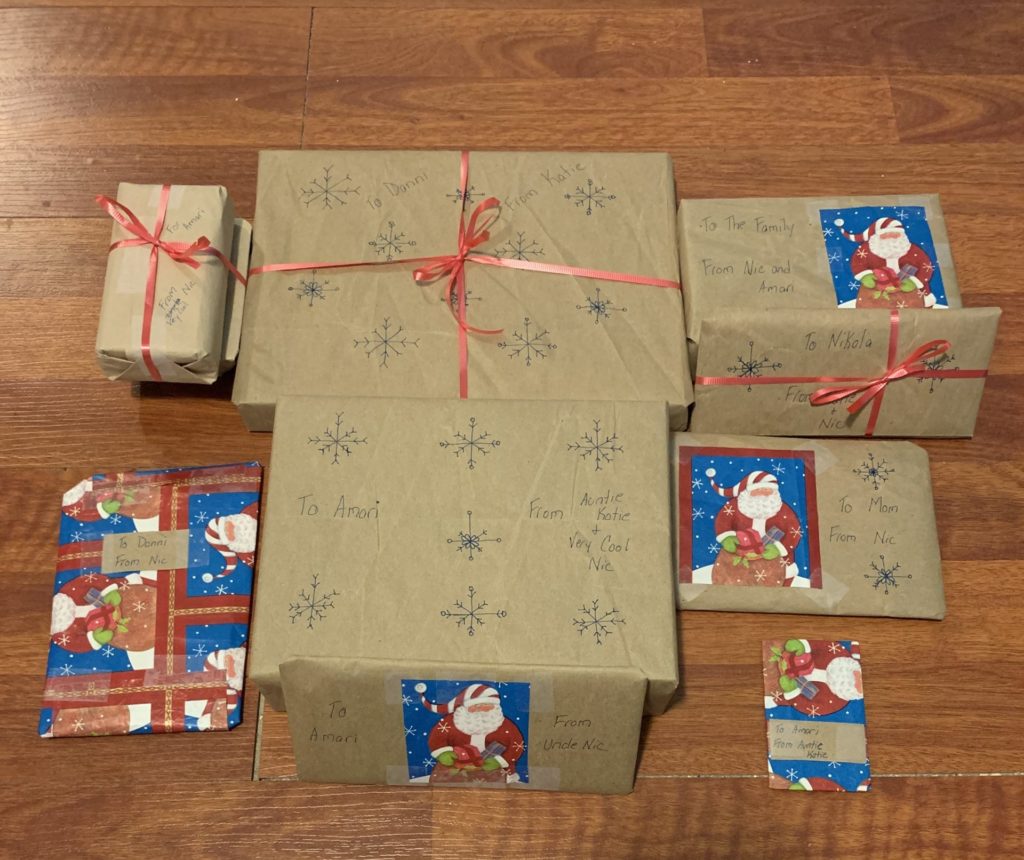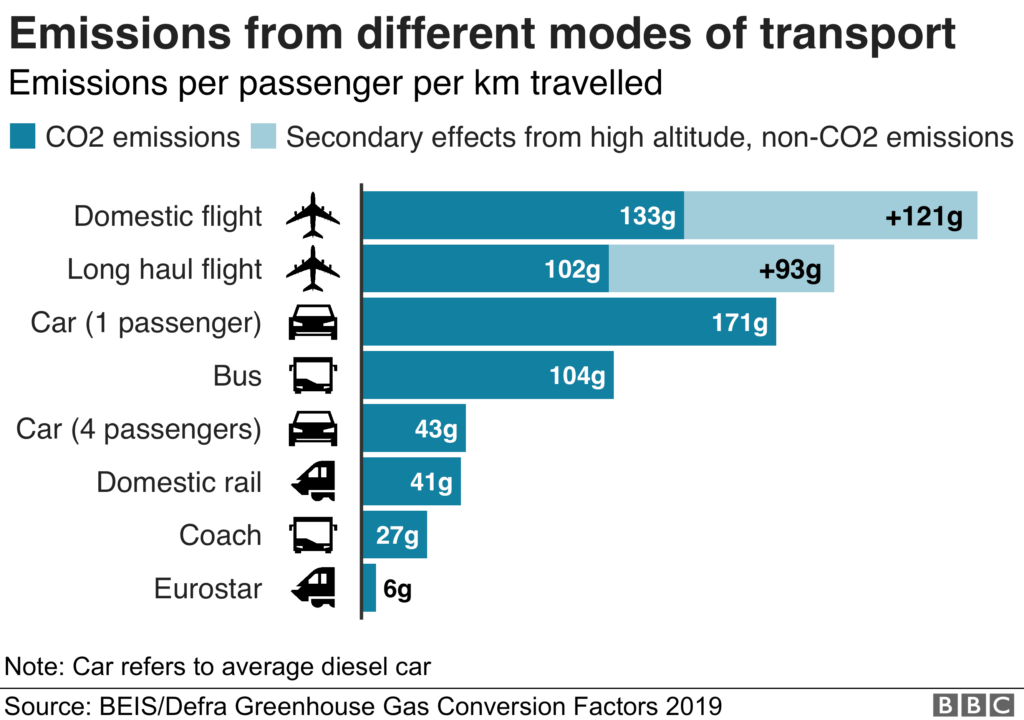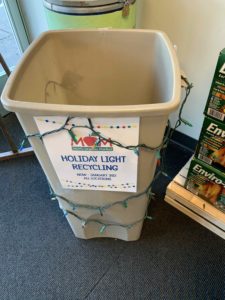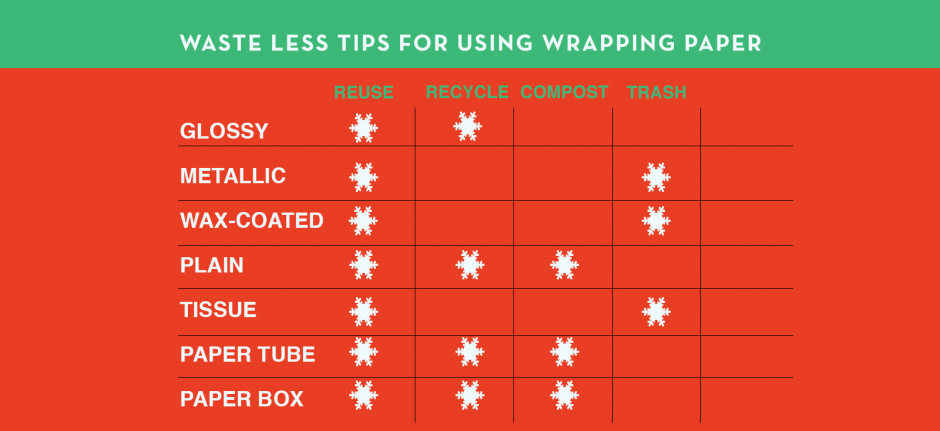If you’re like me, during the past few weeks you shopped, ate, partied, and traveled more than usual. Hopefully you squeezed in more quality time with loved ones as well. There’s always so much to think about around the holidays, and sustainability doesn’t always make the list. This year I’m more aware than ever of the environmental costs of the holidays.
Keep reading to learn more about those costs and how you can focus on sustainability after the holidays.
The Environmental Costs
Shopping
Most of us buy things brand new instead of second hand, and we don’t often think about the impact that has on the environment. It requires resources to make things, and sometimes the creation process gives off harmful emissions that contribute to climate change. Then when we’re done with the product, how we dispose of it can have a major effect on the planet. When we take an item off of the shelf at a store (whether brick-and-mortar or virtual), a brand new item is created to replace it. If the product harms the planet, we are partially responsible for that harm by perpetuating the creation of more products.
There’s also all the packaging involved in purchasing brand new items. If you’re lucky, most of the packaging is recyclable, but there’s almost always bits and pieces that are not easily reusable, like plastic wrap, plastic twist ties, plastic clamshells, and plastic-based tape.
To make matters worse, when we give gifts out around the holidays, we take an already packaged item and add our own packaging around it, i.e., wrapping paper. And most wrapping paper isn’t even recyclable. That’s why this year I only used packing paper from other people’s online orders, discarded scraps of others’ wrapping paper, and ribbon I’ve had sitting around my place for years. Then I hand drew snow flakes on the paper.

Food and parties
Holiday parties often generate a lot food waste. If that food is not composted, it ends up in a landfill, where it decomposes in such a way that it produces carbon dioxide and methane, two greenhouse gases. In contrast, composted food waste creates fertilizer for new plant life, which ultimately reduces carbon dioxide in the atmosphere.
These get-togethers can also involve a lot of plastic, including utensils, flatware, and drinkware. We use them once, throw them away and then forget about them. But they still exist. They may end up sitting in a landfill for hundreds of years. Or they get incinerated which produces greenhouse gases. Sometimes they end up in our oceans where they break down into microplastics, poisoning the birds and fish that eat them.
Air travel
Airplanes produce enormous amounts of greenhouse gases, mainly carbon dioxide. When we fly, we’re responsible for a percentage of those emissions. If we fly business or first class, we’re responsible for a greater percentage because we’re taking up more space. Airplanes use more fuel during take off than in cruising, so if we don’t fly direct we create more emissions.
Often there’s no way around flying. While trains and buses are always better alternatives, they’re not always good options.
It is, however, worth noting that sometimes flying is better than driving, mainly because airplanes can hold so many people. The chart below compares the CO2 emissions of different modes of transport. Note the difference between flying domestically versus driving solo.

It’s not hard to see how quickly all the costs add up. Unfortunately the holidays don’t give us much time to stop and think. I’m here to tell you that it’s never too late to try to pay the planet back. If you’re concerned about your holiday consumption, here are some tips that may help.
Paying Back
Offset your travel emissions
Have you heard of carbon offsetting? In essence you figure out how much carbon dioxide your behavior emits (like flying), and you invest in or donate money to causes that actively work to reduce that specific amount of carbon in the atmosphere, thereby offsetting your emissions. These efforts are usually forestry projects like planting trees or energy projects that focus on fuel efficiency. Examples of the latter can include replacing fuel-inefficient stoves with fuel-efficient ones or giving people access to water filters so they don’t need to boil water which often requires fossil-fuel generated energy. These actions often occur in developing countries.
There are a growing number of websites and apps that enable you to purchase carbon offsets. Some include a flight emissions calculator so you can see your footprint, and then offset that exact amount all in one place.
Here are just a few resources available to you. As you would with any charitable donation, research an organization before you send them any money. I feel comfortable using the ones below, but many more exist.
- MyClimate.org – CO2 Emission Calculator + purchase carbon offsets
- Atmosfair – Flight emission calculator + purchase carbon offsets
- CarbonFund.org – Purchase carbon offsets
- GoldStandard.org – Purchase carbon offsets
- CarbonFootprint.com – Carbon footprint calculator
- The Nature Conservancy – Carbon footprint calculator
- Offcents App – Carbon calculator + purchase carbon offsets in an app
And if you want to learn more about carbon offsets, the following articles offer a more in-depth introduction:
- ThePointsGuy.com – Everything you need to know about carbon offsetting for your flights
- Ontheluce.com – The Traveller’s Guide to Carbon Offsetting Your Flights
- TheGuardian.com – Offsetting Carbon Emissions: ‘It Has Proved a Minefield’
The last thing I’ll say on this topic is that while it’s definitely helpful to offset your carbon emissions, it’s more important to reduce your carbon emissions. Think of it like credit card debt. If you’re trying to pay off a balance, only paying off new charges isn’t going to get you very far. You need to minimize your spending and pay off the outstanding debt. As a species, our carbon credit card is almost maxed out.
Dispose of your decorations properly
Holiday Lights:
- Contact your city’s municipal solid waste office. Hopefully your municipality has a website you can access that gives you advice. In DC (where I live), you can search for “holiday lights” in the What Goes Where? search box at zerowaste.dc.gov.
- Drop off your working or non-working lights at MOM’s Organic Markets. They have locations in the DC, Maryland, Virginia, or Pennsylvania area.
- Mail your non-working lights to a company that will recycle them or sell them to 3rd party recycling facilities. Your options include Christmas Light Source, Holiday LEDs, and Environmental LED. Christmas Light Source donates all the proceeds to Toys for Tots.
- Donate your working lights to Goodwill or your local thrift shop.
- Check with your local hardware store, including Home Depot and Lowes. Some will accept non-working lights.

Real Christmas Trees:
- A lot of cities have a tree recycling program in place for the first couple of weeks of the year. Often those trees are turned into mulch. Check out Earth911.com’s Recycling Directory to find tree recycling program near you. DC Residents can find instructions at the Department of Public Works Leaf and Holiday Collection page.
- Some Home Depot locations will recycle Christmas trees, so check with your local store.
- Check if your local zoo could use the tree. They provide food for animals like goats, pigs and elephants and entertainment for animals like lions.
Artificial Christmas Trees
- Most artificial trees are made from steel and plastic. When they reach the end of their usefulness, there aren’t many great ways to recycle them. You may be able to give the steel skeleton of the tree to a metal scrap recycler, but that plastic is destined for the landfill. Your best course of action is to keep the tree in usable condition for as long as possible. According to the experts at Carbon Trust, “you would need to use this for around 10 years for its environmental impact to be lower than real trees, so keep reusing it.” (The linked article has a lot of other useful info. Check it out.)
- If you’re crafty enough you could try using the branches to make wreaths or garlands.
- When you do choose to get rid of your artificial tree, try donating it before landfilling it. Check with your local thrift store, nursing homes, schools and charities.
Here it’s worth pointing out a misconception I’ve had for a while. I thought cutting down living trees had a more harmful effect on the environment than getting an artificial one, but while doing research for this article, I learned otherwise.
The creation of artificial trees results in carbon emissions, whereas real trees absorb carbon while they’re alive. And the fact that Christmas tree farmers always plant more trees than they sell means their farms are working to reduce carbon, even when some of the trees are chopped down. Additionally real trees can be recycled into mulch or burned safely without contributing to harmful greenhouse gas emissions.
But of course it’s not as simple as, “Real, good. Fake, bad.” Remember everything has a cost. There are greenhouse gasses emitted in the annual transport of living trees at Christmas. And if they do end up landfills they emit methane when they decompose. If you’re as interested in this as I am, see the end of this post for more articles comparing real and artificial trees.
Reduce your consumption going forward
In the spring of 2019 I learned about the zero waste lifestyle, and quickly began making changes to reduce how much waste I send to landfills. I found that the easiest way to do that was to reduce my consumption of products. The more I did that, the more my relationship with products changed. I started to feel personally responsible for any item I brought into my home.
The way I see it, when a company makes a product and I purchase it, we are both on the hook for where that product ends up. There are plenty of responsible companies out there that think about that and make things that are easy to reuse or recycle, but the majority don’t. But I can’t just absolve myself of that responsibility. And I don’t want to. If I send something to a landfill where it will creates greenhouse gases, that is mostly my fault. That is why I’ve I refuse and reuse.
Refuse
One of the easiest ways to reduce your consumption is to refuse items.
- Is someone handing you a business card? Tell them you’d rather take a picture of it. You still get the info, and you’ve delayed their need to print more cards.
- Someone’s trying to get you take a corporate-branded pen at a conference? Tell them no thanks. You’re probably never going to use it, and maybe next year they order less pens.
- Staying at a hotel where they replace your opened toiletries every time they service your room? Put up the Do Not Disturb sign and refuse the service. Better yet try not to use any of the care products in tiny plastic bottles so they don’t have to replace them when you check out.
One great side effect of bringing less “free” items into your life is less clutter in your home which usually leads to less clutter in your mind.
Reuse
Another easy way to reduce consumption is to use reusable items instead of single-use, disposable items. Here are just a few swaps you can make:
- Reusable straws
- Reusable grocery bags
- Reusable produce bags
- Reusable water bottles
- Reusable coffee mugs
- Reusable coffee sleeves
- Reusable silverware, flatware, and drinkware
- Washable cloths instead of paper towels
- Bring your own to-go containers for leftovers when you eat out
- Use a french press or a coffee brewer instead of Keurig machines
Want more? Check out Polly Barks’s article: 80 Zero Waste Swaps for Sustainable Living. Polly is a zero waste and sustainability educator, who “empowers people to be more sustainable so that we don’t all die.” Her site has a lot of great info.
OK, so here’s the thing. Making these swaps is going to be inconvenient for a while. Most new habits are. But once you get over the hump, it’ll just be ingrained. At one point, recycling wasn’t a nation-wide habit, but now most of us at least try. Every little effort you make helps.

Make your unwanted gifts someone else’s treasure
Got a gift you didn’t want for Christmas? Throwing it in the trash is the most wasteful thing you could do, but it’s also not doing anyone any good collecting dust on a shelf. There are so many other things you can do with it.
- Donate it to a person, charity, school, nursing home, or thrift shop.
- Sell it on eBay or to a consignment shop.
- Give it away for free via Craigslist, NextDoor, Freecyle or a Buy Nothing group on Facebook.
- If you live in a city, put them in a box labeled “FREE” and leave it outside your home.
If you prevent someone from buying something new in a store, that’s one less thing that needs to be created to replace it.
I’m so often surprised by the generous and warm spirit I notice in people, often complete strangers, around the holiday season. People just seem to offer up their kindness more easily. I hope you take some time to offer some kindness to our planet. We’ve abused it for so long. It could use some good cheer.
Disclaimer: I’m not a subject matter expert on any of this. I’m just a guy with a search engine and a passion for protecting the environment. In addition to the links included above, you can find the sources of my knowledge in the list below:
- CarbonTrust.com – The Carbon Trust’s Top Christmas Tips
- NYTimes.com – Flying Is Bad for the Planet. You Can Help Make It Better.
- Modernize.com – How to Recycle Old Christmas Lights
- GoodHousekeeping.com – Here’s How You Can Recycle Christmas Lights
- Earth911.com – How to Recycle Christmas Trees
- MentalFloss.com – 5 Animals That Would Love Your Used Christmas Tree
- BusinessInsider.com – How artificial Christmas trees are made
- Blog.TreeClassics.com – How to Recycle Your Artificial Christmas Tree
Real vs. fake Christmas trees:
